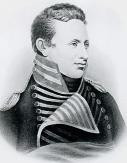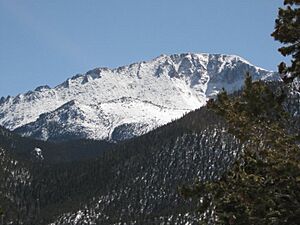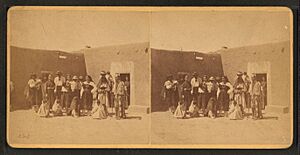Facundo Melgares facts for kids
Quick facts for kids
Facundo Melgares
|
|
|---|---|
| 63rd Spanish Governor of New Mexico | |
| In office 1818 – January 1822 |
|
| Preceded by | Pedro María de Allande |
| Succeeded by | Position abolished |
| 1st Mexican Governor of New Mexico | |
| In office January 1822 – July 1822 |
|
| Preceded by | Position established |
| Succeeded by | Francisco Xavier Chávez |
| Personal details | |
| Born | 1775 Caravaca, Murcia Region, Spain |
| Died | 1823 Santa Fe de Nuevo México, First Mexican Empire (now New Mexico, U.S.) |
| Profession | Soldier and politician |
Facundo Melgares was an important Spanish soldier and leader. He was born in Spain in 1775. He became the last Spanish Governor of New Mexico. After Mexico became independent, he also served as the first Mexican Governor of New Mexico. People described him as a strong and polite soldier.
Contents
Early Life and Education
Facundo Melgares was born in 1775 in Caravaca, Murcia, Spain. His family was important and well-known. He received a good education and trained to be a soldier. He reached the rank of lieutenant in the army.
Military Career and Expeditions
Facundo Melgares started his military career with help from his father-in-law. He was stationed near the northern border of Spanish territory. He stayed there for about ten years.
In 1803, Melgares joined the army at the Presidio of San Fernando de Carrizal. This was south of El Paso del Norte. He fought against the Apaches, who often raided settlements along the Rio Grande. Melgares was also given the job of stopping the Pawnee tribe. They had attacked a Spanish scouting party. Melgares arrived in Santa Fe, New Mexico, with 60 well-equipped soldiers.
Exploring the Frontier: The Louisiana Purchase
The Louisiana Purchase in 1803 made the border between Spain and the United States unclear. On May 30, 1806, Melgares met with the governor of New Mexico, Joaquín del Real Alencaster.
Melgares was given several important tasks. He was to stop American explorers like Lewis and Clark. He also needed to prevent American settlers from moving into the Red River area. Another goal was to explore New Mexico all the way to the Missouri River. Finally, he was to make a treaty with the Pawnee Indians. This treaty would ask them to help stop Americans from moving west.
Melgares led a large group of 105 Spanish soldiers and 400 New Mexican militiamen. He also had 100 Native American allies and over 2,000 animals. He traveled all the way to Nebraska. He successfully made a treaty with the Pawnee. He even planned to build a fort on the Arkansas River.
Meeting Zebulon Pike
On October 1, 1806, Melgares returned to Santa Fe. He brought with him Zebulon Pike, an American explorer. Melgares had captured Pike (or saved him from a winter at Pikes Peak). Even though Spain and the United States were rivals, Melgares and Pike became good friends. Pike's map is still used today to show where Melgares' expedition went.
Melgares' Expedition Destinations
Melgares' expedition traveled to many places, including:
- Taos (where they started)
- The headwaters of the Canadian River (Rio Rojo)
- The Red River
- A Taovayas village
- The Medicine Lodge River
- Turkey Creek
- Kinsley
- Sun City, Kansas
- The mouth of Coon Creek on the Arkansas River
- Great Bend, Arkansas River
- A Pawnee village in Webster County, Nebraska.
In 1810, Melgares was promoted to captain. He led his army against rebels in Saltillo, Coahuila. These rebels were led by Miguel Hidalgo y Costilla, who wanted Mexico to be independent. After several days of hard fighting, Melgares won. The rebel leaders were arrested in March 1811.
Supporting Native American Rights
Melgares was fair in how he dealt with the Navajo and Puebloans. He helped bring the 1812 Constitution to New Mexico. This constitution supported including Native Americans in the government. For example, it gave them the right to vote and hold public office. By the end of 1820, many local governments for Pueblo people had been created.
In 1817, Melgares was promoted again. He became the commander of the Presidio of Santa Fe. He arrived in July 1818 with his experienced soldiers. He worked to defend the city. Later, he became the acting governor of the province. In August 1818, King Ferdinand VII of Spain officially made Melgares the Governor of New Mexico. He was given the rank of lieutenant colonel.
Governor of New Mexico
As Governor of New Mexico, Melgares had many responsibilities. He had to manage civilian activities. He also had to defend the province from local Native American groups and foreign invaders from the north. He was in charge of the soldiers and the civilian militia.
In his first month as governor, the Navajo attacked villages in the north. Melgares asked all citizens of New Mexico to donate food and supplies. He asked for things like grain and metals for weapons. He himself gave cereals, metal, and sheep. A local priest even donated his church bell to be melted down for ammunition. The Presidio of Santa Fe only had 167 soldiers. So, Melgares brought in more troops from Chihuahua and San Eleazario.
In October 1818, Melgares ordered Captain Andrés Gómez Sanudo to attack the Navajo. He wanted the Navajo to surrender or be forced into the Deserts of California.
Protecting the Borders
Melgares had heard rumors of American presence among the Pawnees. He sent Lieutenant Jose Maria de Arce north of the New Mexico border to check these rumors. On September 1, 1818, Arce left Taos with 120 men. Later, 400 more men joined his expedition. Arce traveled to the Platte River but did not find any invading forces. He confirmed that the Native Americans were loyal to Spain. They would warn New Mexico if any invasion was planned.
Despite these reassurances, Melgares asked for 500 more soldiers. He wanted them to strengthen the northern outposts. Melgares also continued fighting the Navajo. He sent 600 soldiers to Taos and 400 to El Vado. He kept 800 men ready to deal with the Navajo.
In February 1819, the commander, General Antonio Cordero, told Melgares to make peace with the Native Americans. Melgares succeeded. On August 21, 1819, he made a formal peace agreement between Spain and the Navajo. The next three years in New Mexico were peaceful.
The End of Spanish Rule
In 1821, an American trader named Thomas James visited Santa Fe. He described Melgares' troops as messy. He also joked about Melgares himself, saying he was very wide and looked like a great general.
Melgares remained loyal to the Spanish king. However, Mexico was becoming independent. Following Agustín de Iturbide's plan for independence, Melgares reluctantly supported the new empire. On December 26, 1821, Melgares was told to swear loyalty to the new Mexican government. In 1821, after Mexico's independence, Melgares welcomed the first American trade group to Santa Fe. On January 6, 1822, a celebration of independence was held.
On July 5, 1822, Melgares was removed from his position as governor. He continued to serve as a soldier under the new governor, Francisco Xavier Chávez. In August 1823, Melgares was cleared of any charges against him. After that, at age 58, he is no longer mentioned in historical records.
Images for kids
See also
 In Spanish: Facundo Melgares para niños
In Spanish: Facundo Melgares para niños










